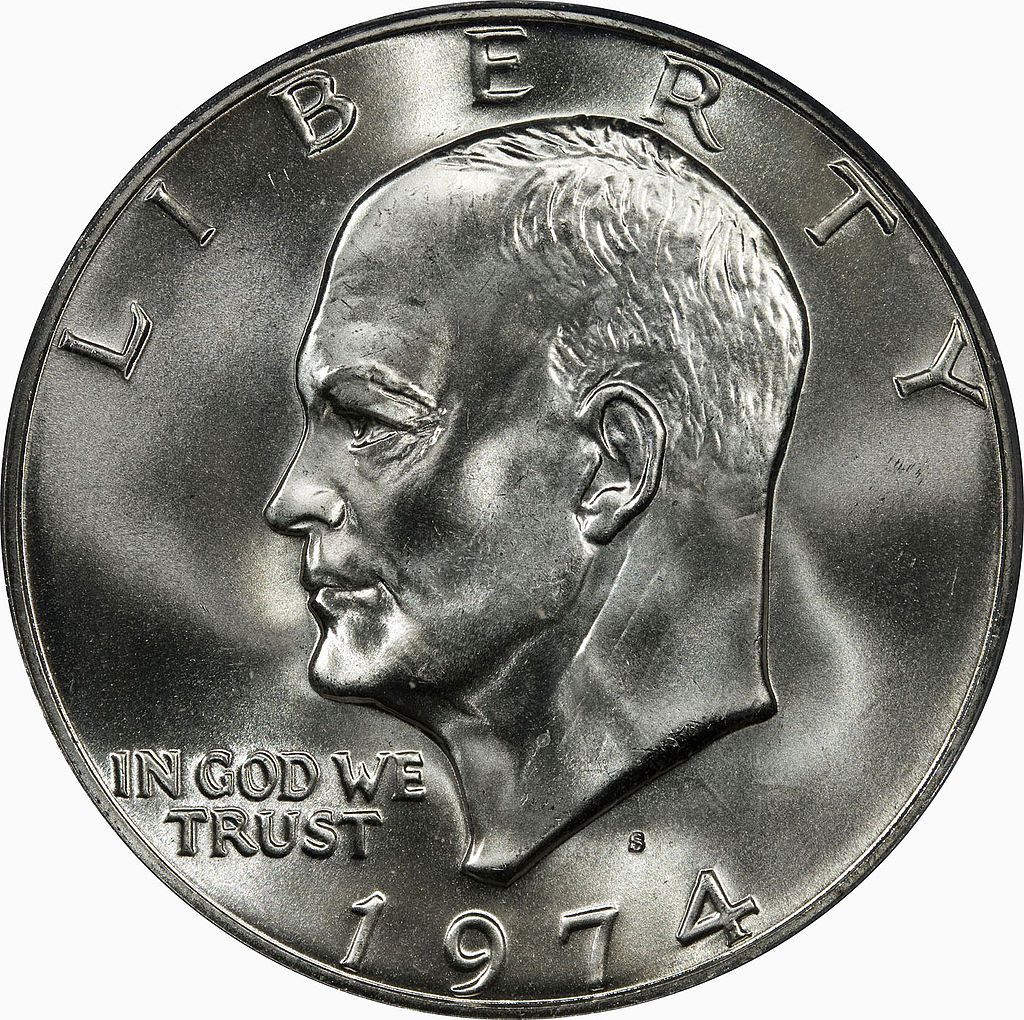Apr 26, 2021 | coins, dollar, US Mint
EDITOR’s NOTE: The release schedule has changed. Please no not use this as a guide as to when to buy. Please visit the
U.S. Mint’s Product Schedule page for precise information.
Without announcement or other fanfare, the U.S. Mint added 2021 Morgan and Peace Dollars to the Product Schedule on the catalog website. The entries linked to their product pages where they buried critical details about the releases.
The pages noted a household limit of 25 coins. When collectors found out and complained, the U.S. Mint lowered the limit to 10 while claiming they are listening to their customers. The household limit is a controversy because of the low product limits placed by the U.S. Mint. Each of the 2021 Morgan Dollar options is limited to 175,000 coins, and the only Peace Dollar option is limited to 200,000 coins.
Why are the product limits so low?
It does not take a degree in marketing to read the numismatic media to understand that there will be a demand for these coins. The ANA pursued passage of this legislation beginning in 2019. Collectors in numismatic forums have discussed the coins. Yet, the U.S. Mint claiming that they are listening to their customers is tone-deaf when it comes to production to satisfy the market.
When a government agency has to do something not exactly the way the public expects, the agency will go about its business trying to generate as little publicity as possible. The U.S. Mint has tried to hide the low product limits and its callous disregard to the collecting community they claim to hear by ignoring the extreme demand these coins will have.
A government agency is supposed to serve the public. If the U.S. Mint is really listening, they will increase the product limits. Otherwise, this is David Ryder playing games at the collector’s expense and should resign as Director of the U.S. Mint.
-

-
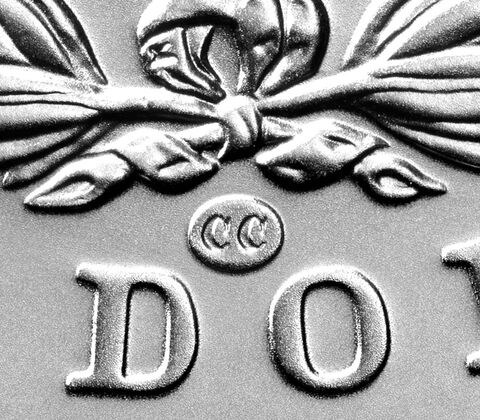
-
CC Privy Mark for the 2021 Morgan Dollar
-

-
O Privy Mark for the 2021 Morgan Dollar
-
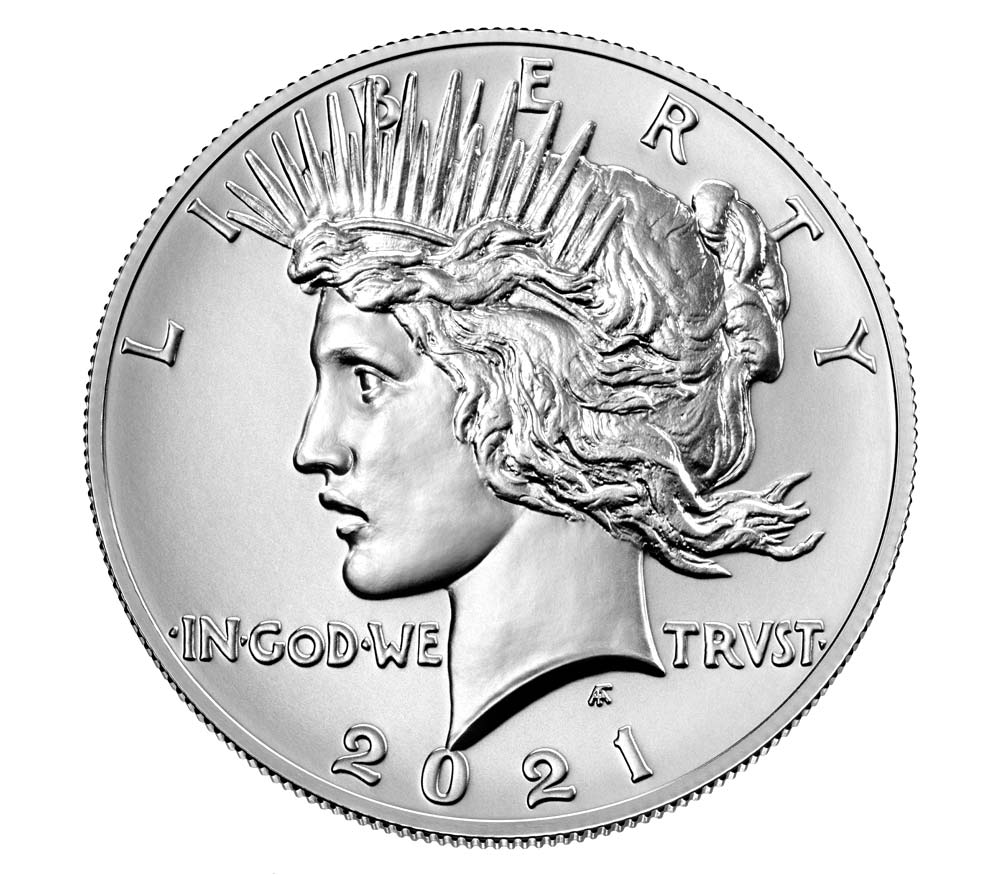
-
2021 Peace Silver Dollar
2021 Morgan and Peace Dollars Specifications
| Denomination: |
$1 |
| Finish: |
Uncirculated |
| Composition: |
.999 Silver |
| Silver Weight: |
0.858 troy oz. |
| Diameter: |
1.500 inches (38.10 mm) |
| Edge: |
Reeded |
2021 Morgan and Peace Dollars Program Information
| Coin |
Privy Mark |
Release Date |
Production Limit |
Price |
| 2021 Morgan Dollar |
“CC” |
May 24, 2021 |
175,000 |
$85.00 |
| 2021 Morgan Dollar |
“O” |
May 24, 2021 |
175,000 |
$85.00 |
| 2021-D Morgan Dollar |
|
June 1, 2021 |
175,000 |
$85.00 |
| 2021-S Morgan Dollar |
|
June 1, 2021 |
175,000 |
$85.00 |
| 2021 Morgan Dollar |
|
June 7, 2021 |
175,000 |
$85.00 |
| 2021 Peace Dollar |
|
June 7, 2021 |
200,000 |
$85.00 |
If you like what you read, share, and show your support 
Apr 25, 2021 | coins
U.S. Mint Announces 2021 Morgan and Peace Dollars Availability
U.S. Mint Backs Off of Higher Household Limits
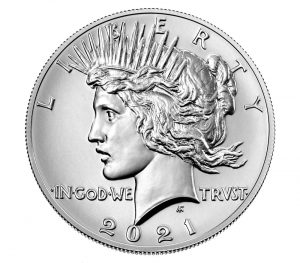 There continues to be a disconnect between the U.S. Mint and the collecting community. First, they announce the availability of the 2021 Morgan and Peace dollar coins with a household limit of 25 coins. Then, claiming they heard collectors, they lower the household limit to 10 coins.
There continues to be a disconnect between the U.S. Mint and the collecting community. First, they announce the availability of the 2021 Morgan and Peace dollar coins with a household limit of 25 coins. Then, claiming they heard collectors, they lower the household limit to 10 coins.
What everyone missed in the announcement is the obnoxiously low mintage limits for these coins. Since the legislation does not specify mintage limits, why is the U.S. Mint limiting the number of coins they are selling? It does not take a professional market analyst to note that the limits will drive profiteering against the collector community. If they need a recent example, look at the 2021-W American Silver Eagle Proof Original Reverse coins.
National Coin Weeks Ends
News watchers may have noticed mainstream news outlets wrote a few more stories about National Coin Week than in the past. The stories included something about the 2021 dollar coins, whether it was the Morgan and Peace tributes or the innovation dollar.
The free offer for Gold Membership to the ANA also ended on Saturday. The ANA will let me know next week how many took advantage of my offer. Although the advertising said that I would sponsor 25, I provided enough money to sponsor 50 new members. I hoped 50 people became ANA members this past week!
And now the news…

April 25, 2021
CHICAGO– U.S. Customs and Border Protection (CBP) officers at Chicago’s International Mail Facility (IMF) recently seized 281 shipments containing various counterfeit coins and $100 bills with 95% of the shipments arriving from China.

→ Read more at
cbp.gov

April 25, 2021
— Astronaut Sally Ride will be depicted on a U.S. coin looking out a spacecraft window at Earth, if the U.S. Secretary of the Treasury agrees with the recommendations made by two advisory panels for the design of quarter dollar to be issued in 2022.

→ Read more at
collectspace.com
If you like what you read, share, and show your support 
Apr 22, 2021 | coins, dollar
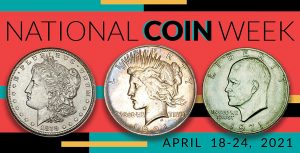 REMINDER:
REMINDER: If you are not a member of the ANA, I will pay your 2021 Gold Membership dues for the
first 25 readers of the Coin Collectors Blog who join during National Coin Week. All you have to do is click
this link and use the Promotion Code
NCW21SB when you check out.
For National Coin Week, all blog posts this will be about large dollar coins. Today, we give some love to the last large dollar coin struck for circulation.
The 1935 Peace Dollar was the last silver dollar struck for circulation. The dollar coin was not very popular because of its size and weight compared with the paper dollar. After silver prices rose and silver dollars were disappearing from circulation, there was a need to mint more coins.
By 1969, the primary customer using the dollar coin was Las Vegas casinos. To satisfy the demand, Mint Director Mary Brooks proposed to issue new dollar coins. Congress rejected Brooks’ proposal to issue silver-clad dollars. Eventually, Congress passed the law to use the same copper-nickel clad composition as other coins.
The selection of World War II general and President Dwight D. Eisenhower was easier to justify following his death on March 28, 1969. To honor Eisenhower, the reverse of the coin would celebrate the formation of the National Aeronautics and Space Administration (NASA), founded in 1958 during his administration. Mint Chief Engraver Frank Gasparro used the Apollo 11 mission insignia for the reverse design.
-

-
Eisenhower Dollar obverse
-

-
Eisenhower Dollar Reverse featuring the Apollo 11 mission insignia
-
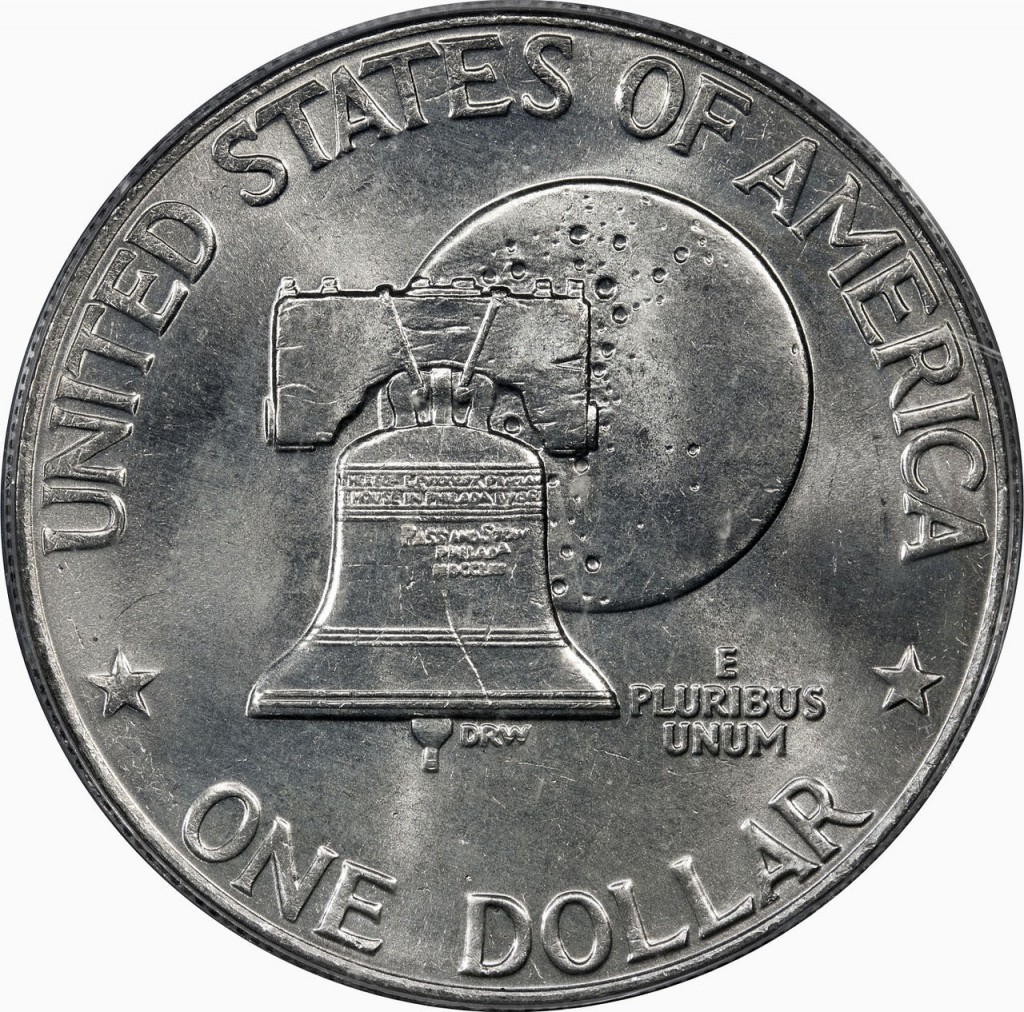
-
Bicentennial Dollar Type 2 (1976) Reverse
In 1975 and 1976, the reverse of the quarter, half-dollar, and dollar coins were redesigned for the United States Bicentennial. The U.S. Mint and the American Revolution Bicentennial Commission held a design competition for the redesign. Dennis R. Williams, a 22-year-old art student, submitted the winning design.
When engraving the dies, Gasparo simplified some of the design so that it would strike adequately. Initial tests did not show any problems. However, when the coins were struck in production, the letters on the copper-nickel circulating coins did not strike well. Gasparo changed the letters by making them thinner and sharper, giving collectors two types of Bicentennial Eisenhower Dollars. The Type 1 dollars were struck in 1975. The Type 2 dollars in 1976.
-
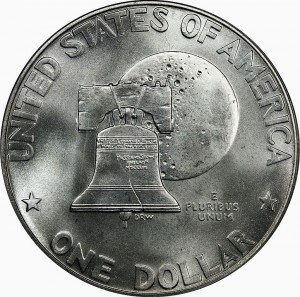
-
Bicentennial Dollar Type 1 (1975) Reverse
-

-
Bicentennial Dollar Type 2 (1976) Reverse
The original reverse with the Apollo 11 mission insignia returned on the 1977 and 1978 coins.
With the cost of copper and nickel rising and the desire to have more dollar coins in circulation, the Eisenhower Dollar was replaced by the Susan B. Anthony dollar. The Susie B. was smaller and used the Apollo 11 mission insignia on the reverse, but it was confused with the quarter and rejected by the public.
A complete collection of business strike Eisenhower Dollars consists of 16 coins. Uncirculated silver coins struck using a 40% silver-clad alloy was for four years. These are called “Blue Ikes” describing the Blue Packs similar to those used by the GSA for circulating silver dollars. An uncirculated silver-clad coin was available in the three-coin Bicentennial Silver Set. There are five silver-clad uncirculated coins.
From 1971-1974, the U.S. Mint issued silver-clad proof Eisenhower Dollars using the similar plastic lens that the GSA used for the Carson City Morgan silver dollars. The lenses were packed in brown boxes giving their nickname “Brown Ikes.” Copper-nickel clad proof coins were available in annual proof sets. An additional silver-clad proof coin was available in the three-coin Bicentennial Silver Proof Set. There are five silver-clad proof coins of the 11 proof coins struck by the U.S. Mint.
An advanced collector may consider expanding their collection to include the varieties of the 1972 dollars. Because of the difficulties in striking the silver-clad coins, the image of the Earth did not strike well. During the year, Gasparo tried twice to fix the problem giving the coin three distinct types.
A complete collection of Eisenhower Dollars consists of 32 coins. Because the coin was challenging to strike, finding coins in the highest grades is expensive. But collectors can assemble an attractive set for a reasonable amount of money. If you wanted to add the three varieties in 1972, the Type II version is scarcer and might be more expensive than the rest of the set and maybe a nice challenge.
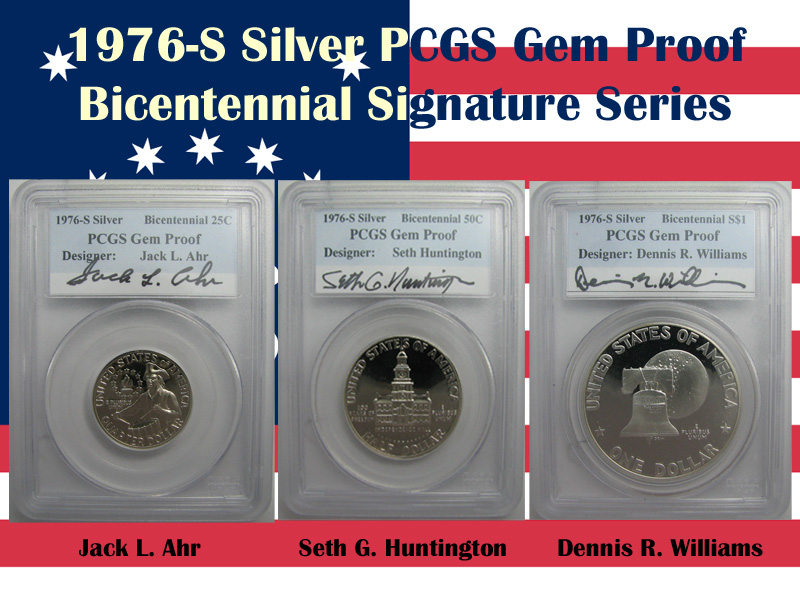
From my collection: 1976-S Silver Proof Bicentennial Autograph Set
If you like what you read, share, and show your support 
Apr 21, 2021 | Carson City, coins, dollar, silver
 REMINDER:
REMINDER: If you are not a member of the ANA, I will pay your 2021 Gold Membership dues for the
first 25 readers of the Coin Collectors Blog who join during National Coin Week. All you have to do is click
this link and use the Promotion Code
NCW21SB when you check out.
For National Coin Week, all blog posts this will be about large dollar coins. The following is a about the GSA Morgans and the few in my collection.

GSA Sale #3 stepped up its advertising (Image from u/GucciMamba666 on Reddit)
By 1964, the price of silver skyrocketed, making U.S. coins worth less than the metals used to make them. The economics led to a fiscal crisis that had the government rethinking the monetary system.
Silver coins were no longer required to back the U.S. dollar. Along with a law passed by Congress that ordered the General Services Administration to consolidate the government’s real estate usage came the discovery of the largest hoard in history.
Before the GSA started to clean out government-owned buildings, the government knew that they had stored silver coins in a few places. They did not know how many there were and the number of places they were stored.
Congress passed laws that caused over-production and hoarding. The Coinage Act of 1873, also called “The Crime of ’73,” caused a withdrawal of silver from the market. The Bland-Allison Act overturned it in 1878 that required the Treasury to purchase silver from U.S. mines to strike dollars for circulation. Since most silver mining was in Nevada, the Carson City Mint was striking more coins than needed.
The Sherman Silver Purchase Act became law in 1890. It raised the monthly amount of silver the Treasury purchased to 4.5 million ounces per month. The goal was to boost the economy to stem inflation. The law caused more dollars produced in Carson City with no place to distributed them.
To help Great Britain fund their war efforts, the Pittman Act authorized the melting of 350 million silver dollars to be sold at $1.00 per ounce. By the end of the war, over 270 million coins were melted for bullion. It was not enough to deplete the storage. The Act required the Mint to strike new coins with the silver repaid by Britain by 1933.
After several years of cleaning out vaults in different government-owned buildings, the GSA found 2,825,219 Morgan Dollars with the CC mintmark. They also found 112,145 coins from other branch mints. Within those additional coins, the GSA found 84,165 circulated Seated Liberty, Morgan, and Peace Dollars.
The government did not know what to do with the coins. Since they were in Treasury’s vaults, it was up to the Treasury to decide what to do with them. The Treasury’s role changed with the passage of the Federal Reserve Bank Act of 1913 and said that the best they could do was melt the coins. The U.S. Mint did not want the coins back since their job is to produce the coins. The Federal Reserve claimed it had no jurisdiction over the coins since the production and storage occurred before the formation of the Fed.
The GSA was the only agency that had experience liquidating government surplus. But these coins were not ordinary. Many collectors predicted that the sale of these coins would significantly change the numismatic market.

An 1884-O uncirculated Morgan Dollar from the GSA Sale
To sell these coins, the GSA created a special hardpack to hold the circulated coins. The hard-pack would be placed into a box with a certificate of authenticity, and the coins were made available through a mail-bid auction sale.
Coins struck in Carson City would be housed in a plastic case called a lens that said “Carson City” across the top. Other uncirculated coins were placed in a generic case. These coins are called GSA Morgans or GSA Non-CC Morgans.
For circulated coins, the GSA created the Soft Pack. The coins were sealed in mylar with a plastic token and placed in a blue envelope. Collectors refer to these coins as GSA Blue Packs. The GSA did not keep records of the number of Blue Packs sold. However, some have estimated that the GSA created about 100,000 Blue Packs.
-

-
GSA Bluepack Envelope
-

-
1922 Peace Dollar in GSA Bluepack package
-
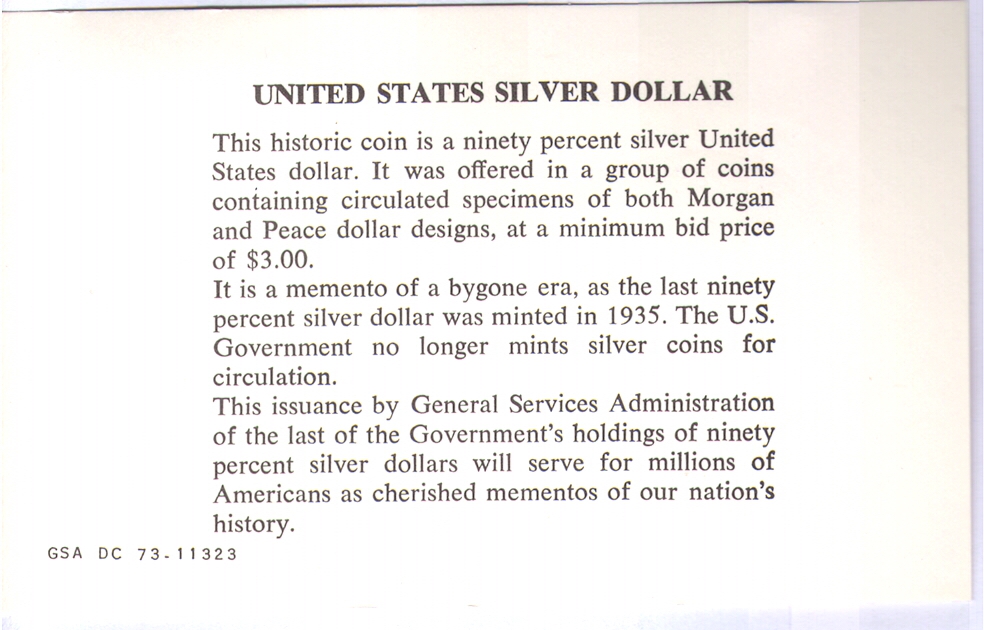
-
GSA Bluepack COA
-

-
GSA Information about the sale of the coins
From 1972 through 1980, the GSA held a series of eight sales. Most were mail-bid type auctions. The last two in 1980 were call-in bidding sales.
My father was cleaning his house, preparing to move into a condo before the pandemic shutdowns and found his GSA Morgan Dollars. He mailed the coins to me for my collection. Three are Carson City dollars, and one struck in New Orleans. My father purchased the coins during the first two GSA sales. He said that he tried to purchase more during the 1980 sales but was outbid.
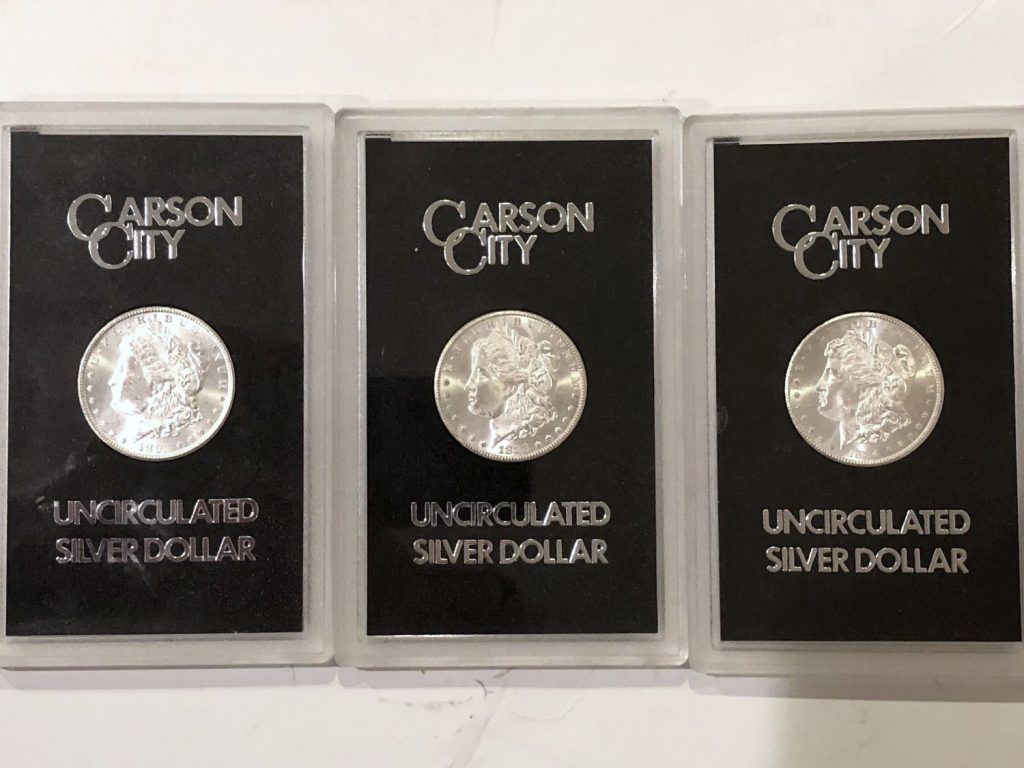
L-to-R: 1882-CC, 1883-CC, and 1884-CC Morgan Dollars in GSA holders
I will eventually send the coins to NGC to have them graded in their original holder. For now, I found an online seller with four empty GSA boxes. Since I have the original Certificates of Authenticity, I will have complete packages.
GSA Preview Movie
Preview from the 1971 GSA movie about the hoard of silver dollars. As you watch the
video, think about what it might have taken for the GSA workers to sort through 3 million coins.
If you like what you read, share, and show your support 
Apr 20, 2021 | coins, dollar, silver
REMINDER: If you are not a member of the ANA, I will pay your 2021 Gold Membership dues for the
first 25 readers of the Coin Collectors Blog who join during National Coin Week. All you have to do is click
this link and use the Promotion Code
NCW21SB when you check out.
For National Coin Week, all blog posts this will be about large dollar coins. The following is a personal story about Morgan and Peace dollars I recently found in my late father’s house.
When my father’s firstborn son appeared in 1960, he planned two ceremonies. The first occurred eight days after the birth. Formally called the brit milah or bris in Yiddish, the male child undergoes a ritual circumcision. The second comes 30 days after the birth, called the pidyon haben, or “redemption of the firstborn son.”
For this ceremony, the kohen, the priestly descendent of Aaron, takes the child, and the parents must pay 5 Shekels to redeem their son. The ceremony is to recognize that the firstborn of Egypt were slain before the exodus.
A modern interpretation of the 5 shekels is the use of five silver dollar coins. In other countries, they used five silver coins representing the unit of currency for their country. Since most countries have converted to using base-metal currency, the Bank of Israel issues silver Pidyon Haben coins for Jewish people to use.
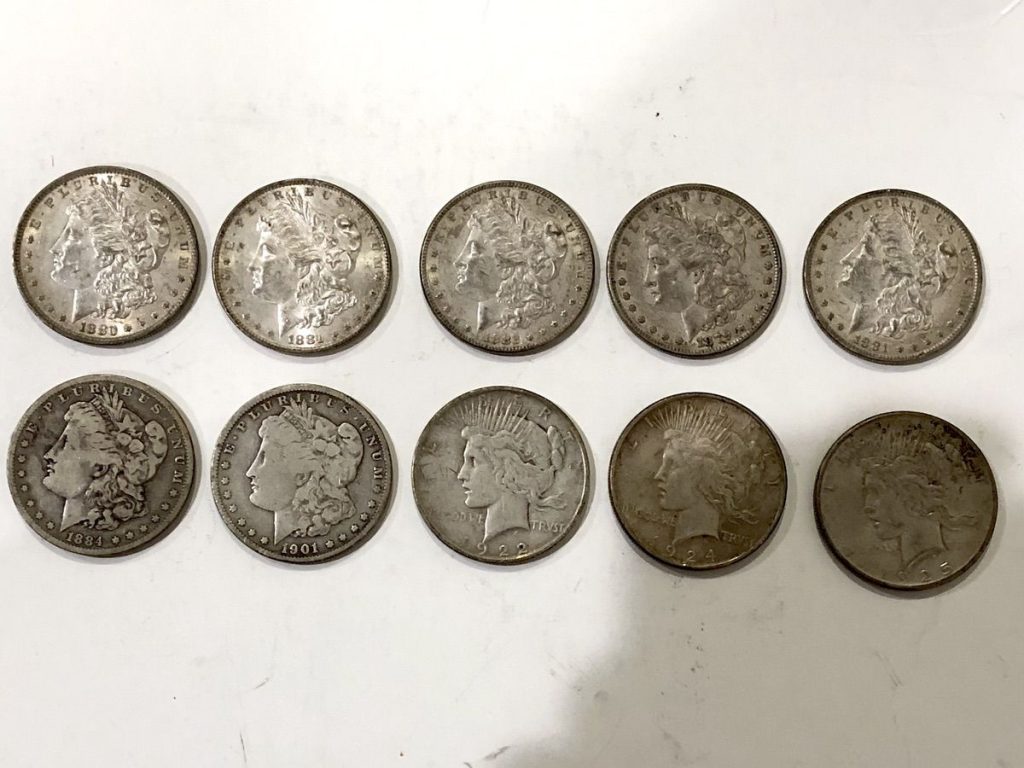
The 10 Silver Dollars as the Shekels stand-ins
Following my father’s passing from COVID-19, we cleaned out his house and found a separate box from the rest of his coin collection. Opening the box, I found ten coins wrapped in tissue. There were seven Morgan Dollars and three Peace Dollars. Under the coins was a paper in my late mother’s handwriting with the English and Hebrew names if their first child was a boy or a girl.
The box contained other hints making it clear that these were the coins used for my pidyon haben. There was also a note that said “Uncle Henry.”
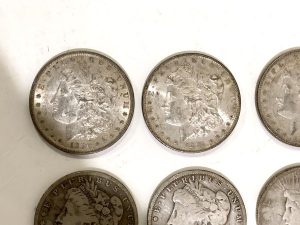
Two of the better quality Morgan dollars
Uncle Henry and Aunt Ruthie passed in 1999. Sometimes, Aunt Ruthie would joke that Uncle Henry should have kept me.
I do not know which of the five coins were used for my pidyon haben, but I am sure he did not use the Peace Dollars. He would have used five matching coins. However, the ten silver dollar coins will remain as a set as part of my collection.
-

-
The Peace Dollar that were not likely used for the ceremony
-

-
Three of the dollars were struck in New Orleans
If you like what you read, share, and show your support 
Apr 19, 2021 | administrative, ANA

This year, National Coin Week celebrates the anniversary of the last of the large dollar coins. One hundred years ago, the U.S. Mint brought back the Morgan dollar while coming up with a new design that eventually became the Peace Dollar. Also, 50 years ago, the U.S. Mint began production of the Eisenhower dollar. These three coins were 38.1 mm in diameter and were the last of the large circulating coins.
As part of the Nation Coin Week Celebration, the American Numismatic Association is offering a discount on the GOLD (digital) membership. For $5, you can join the ANA for one year.
Let’s make joining the ANA more fun! The first 25 new members who join the ANA through
this link will pay
Zip, Zilch, Nada!If you are not a member of the ANA, I will pay your 2021 Gold Membership dues for the
first 25 readers of the Coin Collectors Blog who join during National Coin Week. All you have to do is click
this link and use the Promotion Code
NCW21SB when you check out.
In addition to being the world’s largest numismatic organization, the ANA offers collectors resources to learn more about your collection. Aside from the shows, my three favorite resources are:
- The Numismatist. There are a lot of great writers talking about numismatics. The Numismatist brings you the best of the writing that can inspire you to learn more or spend money on new collectibles. With the Gold Membership, The Numismatist is delivered electronically so you never have to worry about it being lost or damaged in transit. Since the ANA has digitized every issue dating back to 1888, it serves as a historical reference of numismatic knowledge. Members can access the digital archives from any computer and there is an app for tablets.
- The Dwight N. Manley Numismatic Library. If it is not printed in The Numismatist, the Library has more than 128,000 items that members can check out. All you pay is shipping, and you can check out books, catalogs, and other resources. I have a box of books I am going through now!
- Directly submit coins to NGC. As an ANA member, you can apply for an account with NGC and send your coins directly for grading and encapsulation. Currency collectors can submit their collectibles to PMG. You will have to pay for the grading service but you can submit without becoming an NGC or PNG member.
JOIN TODAY!
Click
this link and the first year of your GOLD membership is FREE!
Offer expires on April 24, 2021 or when 25 new members join only at info.money.org/ncw-2021-barman.
If you like what you read, share, and show your support 
Apr 18, 2021 | celebration, coins, dollar
WELCOME TO NATIONAL COIN WEEK!
 Starting today, April 18, 2021, through April 24, National Coin Week celebrates “Money, Big and Bold,” the history of the large dollar coin. The influence for this year’s NCW theme is the 100th anniversary of the revival of the Morgan Dollar and the first issue of the Peace Dollar. It is also the 50th anniversary of the first Eisenhower Dollar, the last of the large dollar coins.
Starting today, April 18, 2021, through April 24, National Coin Week celebrates “Money, Big and Bold,” the history of the large dollar coin. The influence for this year’s NCW theme is the 100th anniversary of the revival of the Morgan Dollar and the first issue of the Peace Dollar. It is also the 50th anniversary of the first Eisenhower Dollar, the last of the large dollar coins.
The dollar coin has had a fascinating history in the United States. Before paper money and during the wild days referred to as Broken or Obsolete Banknotes, before the National Bank Act of 1863, coins were considered safer than the barely regulated paper. As with many policies of the time, paper money was more in favor in the eastern United States than in the west. The west preferred the coins.
In 1918, Congress passed the Pittman Act, whose purpose was to supply the British with silver to help with their war effort. When the British repaid the United States, the government had to produce silver coins to replace coins melted to create the bullion shipped to Britain.
In 1921, the U.S. Mint had not produced a silver dollar since 1904 and did not have dies to produce coins. Chief Engraver and the coin’s designer Charles Morgan created new master dies to produce coins.
When the U.S. Mint discussed creating the new dies, former ANA President Farman Zerbe presented a paper at the 1920 World’s Fair of Money proposing the Peace Dollar. Congress eventually agreed, which led to the committee that picked Anthony di Franchisci’s design. Production of the Peace Dollar began in 1921.
The Peace Dollar almost made an appearance in 1964 when Congress proposed striking a new dollar coin. But the silver shortage and the end of using silver for circulating coinage ended this program. Allegedly, the U.S. Mint destroyed all 1964 Peace Dollar patterns.
In 1969, Mint Directory Mary Brooks wanted to issue dollar coins. As part of the negotiations with Congress to authorize a new coin, she suggested honoring the former World War II General and President Dwight D. Eisenhower. The suggestion convinced Congress to pass the legislation, and the U.S. Mint began Eisenhower Dollar production in 1971.
In 1975, the U.S. Mint was concerned with the level of resources required to produce the coin. Negotiations began to produce a smaller dollar coin. The results of these negotiations led to the introduction of the Susan B. Anthony Dollar in 1979, ending the production of the large circulating dollar coin.
All of the posts this week will be about large dollar coins except for Monday. Monday’s post will have a special announcement.
And now the news…

April 13, 2021
In the viral video, Webber explained that the giant safe was so big they had to hire a crane to retrieve it. He said they thought it might contain something. So they made the decision to break it open.

→ Read more at
pennlive.com

April 13, 2021
Two Jacksonville ISD students in the Gifted and Talented program are using their coin collections for their GT projects. According to GT teacher Chelsea Best, the students’ GT project is one in which students conduct independent research on a subject of their own choosing.

→ Read more at
jacksonvilleprogress.com

April 13, 2021
The images on the world's smallest commemorative coin are too small to see with the naked eye A tiny Swiss gold coin bearing a picture of Albert Einstein sticking his tongue out has been crowned as the world's smallest commemorative coin, Switzerland's mint announced Tuesday.

→ Read more at
phys.org

April 13, 2021
(Kitco News) Even though gold's spot prices are still trading below $1,750 an ounce, the real price of gold is a few hundred dollars higher, according to Ed Moy, former U.S. Mint director and currently chief market strategist at Valaurum.

→ Read more at
kitco.com

April 17, 2021
B. Max Mehl, an immigrant lad who clerked in a shoe store for 25 cents a week, made a fortune from small change. When customers paid, he examined their cash for rare pennies, nickels, dimes and half dollars.

→ Read more at
star-telegram.com

April 18, 2021
The surprise discovery of three jam jars filled with gold bars and hundreds of gold coins in an old building marked for renovation has left a mountain community in eastern France perplexed and celebrating.

→ Read more at
theguardian.com
If you like what you read, share, and show your support 
Apr 12, 2021 | coins, gold, news
Some can make an argument to call the Farouk-Fenton 1933 Saint-Gaudens Gold $20 Double Eagle coin the most famous coin in the world. Although other coins have surpassed it in price since Stuart Weitzman purchased it in 2002, its legend lives beyond any other coin.
The story of the coin spans families, generations, continents, court cases, and was almost destroyed in the World Trade Center on September 11, 2001. Its story was told in two excellent books and the revealing of the coin’s current owner made international headlines.
Now, the world’s most famous coin has been certified, graded, but not entombed in plastic. Sotheby’s requested the grading and certification for the coin and asked that the coin not be slabbed. PCGS graded the coin and provided an image certification. They also announced that the new owner could submit the coin for holdering after the auction.

Although certification is necessary for some coins in this day of counterfeits, there are some coins whose importance goes beyond the need to entomb them in plastic away from the world. The last legal tender gold coin from the time Franklin D. Roosevelt withdrew gold from the market is one of those coins.
There have been other famous coins displayed in slabs that give them a lonely feel. Looking at any of the five 1913 Liberty Head Nickels makes it seem like it’s trapped instead of proudly standing, showing off its fascinating story. The same fate awaits the 1933 Double Eagle should its next owner decide the plastic is more important than the coin.
For the sake of allowing the legend to live, I hope the next owner decides not to hide this coin in plastic and allows the world to celebrate its story and beauty.
And now the news…

April 5, 2021
A magnified view of corrosion on one of the medieval Islamic coins being examined and restored by the Louvre Abu Dhabi.Department of Culture and Tourism – Abu Dhabi In a newly acquired cache of more than 2,800 coins dating to Islam’s medieval era, the Louvre Abu Dhabi not only has a bounty for its permanent collection, but also signposts on the road map of early Islam, all coated in tarnish, corrosion and the mystery of history.

→ Read more at
nytimes.com

April 6, 2021
A 17th-century Arabian coin discovered by Jim Bailey. Courtesy of the American Numismatic Society via Flickr.

→ Read more at
news.artnet.com

April 7, 2021
This gold "Memento Mori" ring, dating to the Tudor period, sports an enamel skull.

→ Read more at
livescience.com

April 9, 2021
If the infamous rum-soaked Jack Sparrow of Pirates of the Caribbean dropped some of his pocket change while drunkenly dancing around when he was supposed to be pillaging and plundering, what would you expect to find 325 years later?

→ Read more at
syfy.com
If you like what you read, share, and show your support 
Apr 4, 2021 | coins, news, quarter
 In a few days, the U.S. Mint will release the last of the five-ounce silver America the Beautiful Quarters. The ATB series was a follow-up to the 50 State Quarter Program to honor the nation’s national parks and forests. The order of the program was determined by the date the area became a national park or forest.
In a few days, the U.S. Mint will release the last of the five-ounce silver America the Beautiful Quarters. The ATB series was a follow-up to the 50 State Quarter Program to honor the nation’s national parks and forests. The order of the program was determined by the date the area became a national park or forest.
The Tuskegee Airman National Historic Site in Tuskegee, Alabama, became a registered historic site on November 6, 1998. Formerly Morton Field, the site was the Tuskegee Airmen’s base and training center, the only African-American division of the U.S. Army Air Corps during World War II.
The end of the ATB quarters also ends the corresponding five-ounce hockey puck-sized bullion coin issues. The big coins are popular with investors and some collectors.
Now that the ATB quarters program has ended, a reverse celebrating George Washington’s crossing the Delaware River will replace the reverse for the rest of 2021. In 2022, the quarters will feature prominent women in United States history. The program will last until 2026, when the quarters’ design will celebrate the American Semisesquincentenial (250 years).
And the law that extended the circulating commemorative programs also includes the provisions for the U.S. Mint to create five-ounce silver hockey puck-sized coins from almost any program.
And now the news…

March 29, 2021
In the midst of one of the most comprehensive conservation projects currently taking place in Israel, archeologists in Jerusalem’s Old City discovered a Tyre coin, believed to have been used to pay the Temple tax by pilgrims making their way to the Temple for Passover, Shavuot or Sukkot.

→ Read more at
jpost.com

March 31, 2021
Indigenous men and women who have served in the military have been commemorated through Australia’s newest circulating $2 coin launched by the Royal Australian Mint yesterday, 30 March.

→ Read more at
canberraweekly.com.au

April 2, 2021
A 17th century Arabian silver coin, top, that research shows was struck in 1693 in Yemen, rests above a 1652 Massachusetts Bay Colony Oak Tree Shilling , and a 1727 Spanish half real coin, on a table, in Warwick, Rhode Island, March 11, 2021.

→ Read more at
voanews.com

April 2, 2021
Gold coins cast a spell. The pile of coins found in a wall in Caesarea and now displayed in a glass case at the Israel Museum in Jerusalem begs questions.

→ Read more at
haaretz.com

April 3, 2021
This Is Why The Police Are Involved In Every Pawn Stars Transaction

→ Read more at
looper.com
If you like what you read, share, and show your support 
Apr 2, 2021 | coins, legislative, news
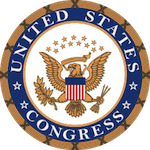 Every month we look at the numismatic legislation that Congress worked on the previous month. Since the 117th Congress is only three months into its first session, most of the legislative action is introducing bills.
Every month we look at the numismatic legislation that Congress worked on the previous month. Since the 117th Congress is only three months into its first session, most of the legislative action is introducing bills.
Nowadays, Congress members do not have to drop their papers into the hopper in their respective chambers. Bills are submitted electronically. To prove that they are doing something, these legislators also post the bill on their official websites. Inevitably, an intern or low-level staffer makes a mistake that gets misinterpreted by the press, making it sound like a bill has been passed. According to the Government Printing Office, there has been no numismatic-related bill that has made it past its committee assignment.
A few days ago, Rep. Alexander Mooney (R-WV) introduced H.R. 2285, a bill “To amend the Internal Revenue Code of 1986 to clarify that gain or loss on the sale or exchange of certain coins or bullion is exempt from recognition.” Although this bill’s text has yet to be published, the title suggests that it will make the sale of coins and bullion exempt from capital gains taxes.
Currently, collectors who sell items from their collections are required to pay capital gains taxes on the profit from the sale of their coins. If you bought a coin for $100,000 then sell it for $150,000, the capital gains tax is applied to the $50,000 profit. Under the 2020 rate schedule, that is a 0% tax, except if you bought the coin within the last year, it is taxed as part of your regular income. But if you bought the coin for $50,000 before 2020 and sold it for $150,000 in 2020, then the $100,000 profit is taxed at 15%.
Are you confused? This is why the potential of eliminating the capital gains tax on coins and bullion will help the industry.
Here is the list of the eight bills introduced in March 2021.
H.R. 1648: To require the Secretary of the Treasury to mint coins in recognition and celebration of the National Women’s Hall of Fame.
Introduced in House — Mar 8, 2021
Referred to the House Committee on Financial Services. — Mar 8, 2021
S. 672: A bill to amend title 31, United States Code, to save Federal funds by authorizing changes to the composition of circulating coins, and for other purposes.
Introduced in Senate — Mar 10, 2021
Read twice and referred to the Committee on Banking, Housing, and Urban Affairs. — Mar 10, 2021
H.R. 1842: To require the Secretary of the Treasury to mint commemorative coins in recognition of the Bicentennial of Harriet Tubman’s birth.
Introduced in House — Mar 11, 2021
Referred to the House Committee on Financial Services. — Mar 11, 2021
H.R. 1789: To amend title 31, United States Code, to save Federal funds by authorizing changes to the composition of circulating coins, and for other purposes.
Introduced in House — Mar 11, 2021
Referred to the Committee on Financial Services, and in addition to the Committees on the Budget, and Rules, for a period to be subsequently determined by the Speaker, in each case for consideration of such provisions as fall within the jurisdiction of the committee concerned. — Mar 11, 2021
S. 697: A bill to require the Secretary of the Treasury to mint commemorative coins in recognition of the Bicentennial of Harriet Tubman’s birth.
Introduced in Senate — Mar 11, 2021
Read twice and referred to the Committee on Banking, Housing, and Urban Affairs. — Mar 11, 2021
H.R. 1900: To require the Secretary of the Treasury to mint coins in commemoration of the health care professionals, first responders, scientists, researchers, all essential workers, and individuals who provided care and services during the coronavirus pandemic.
Introduced in House — Mar 16, 2021
Referred to the House Committee on Financial Services. — Mar 16, 2021
S. 867: A bill to require the Secretary of the Treasury to mint coins in recognition and celebration of the National Women’s Hall of Fame.
Introduced in Senate — Mar 18, 2021
Read twice and referred to the Committee on Banking, Housing, and Urban Affairs. — Mar 18, 2021
H.R. 2284: To amend the Internal Revenue Code of 1986 to clarify that gain or loss on the sale or exchange of certain coins or bullion is exempt from recognition.
Introduced in House — Mar 29, 2021
Referred to the House Committee on Ways and Means. — Mar 29, 2021
If you like what you read, share, and show your support 






 → Read more at
→ Read more at 




















